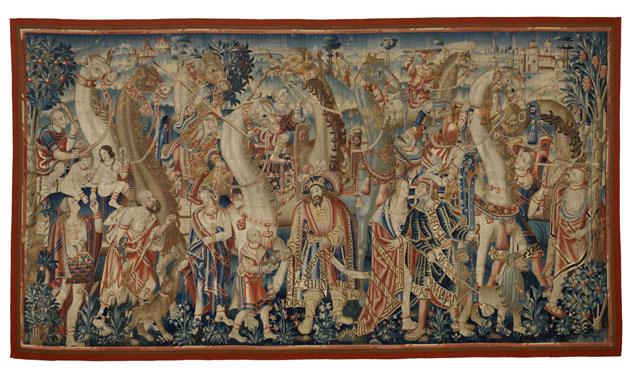Details
- Object type
tapestry
- Title
Exploration of the Indies: The Camel Caravan
- Place Associated
Southern Netherlands, Spanish Netherlands, Hainaut, Tournai (probably) (place of manufacture)
- Date
circa 1500-1530
- Materials
wool (warps), wool (wefts), silk (wefts), 4-5 warp threads per cm, 2 ply S Z
- Dimensions
overall: 3600 mm x 6520 mm 30000 g (approx wt)
- Description
-
Tapestry woven with wool and silk wefts and wool warp depicting Exploration of the Indies: The Camel Caravan. Eight long-necked camels, one now blue, with exotically dressed or partially undressed men and women, two men in the foreground with inscriptions on their robes, children and a small animal arranged in front, on or behind the camels. Set in a landscape with buildings and fruit trees in background, and flowering plants in the foreground. Red, brown and shaded golden yellow border.
Elizabeth Cleland states that: 'Many of the Exploration of the Indies tapestries seem to follow a narrative sequence, from the Hunt, through the Camel Caravan and the Giraffe Caravan, to the Embarkation of the Exotic Animals, and it is possible that these tapestry series were conceived as multiple-piece sets representing Vasco da Gama's entire journey and containing as many as ten hangings each. However, tapestries portraying Exploration of the Indies' subjects could also appeal as single pieces. Although documentary sources reveal that prestigious patrons such as Duke Philip the Handsome of Burgundy, and the Holy Roman Emperors Maximilian I and Charles V all purchased editions, references also show that weaver-dealers such as Arnould Poissonnier produced Indies tapestries on speculation, keeping a stock of such pieces in their warehouses for sale as the opportunity arose. Certainly in the case of the Burrell Collection's Camel Caravan, it is apparent that the tapestry's cartoon was reused on at least one occasion. There also seems to have been a lively second-hand trade in this type of tapestry: it has been suggested, for example, that the ten-piece Calycoto set, described as ‘somewhat worn' in the 1522 inventory of Cardinal Thomas Wolsey's possessions, had been part of a group of second-hand tapestries which the Cardinal had acquired from contacts in Tournai.'(Cleland, E. and Karafel, L., (2017). Glasgow Museums: Tapestries from The Burrell Collection, 384-5).
See also Legacies of Slavery – Voyages of Exploration and Exploitation
Provenance: Charles, Vicomte de Noailles; John Hunt, London; from whom purchased by Sir William Burrell, 28 October 1937, for £990.
- Credit Line/Donor
Gifted by Sir William and Lady Burrell to the City of Glasgow, 1944
- Collection
Burrell Collection: European Tapestries
- ID Number
46.94
- Location
Burrell Collection
